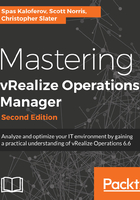
Service Discovery solution
The VMware vRealize Operations Service Discovery Management Pack (SDMP) is a service awareness adapter for vRealize Operations that provides continuous dependency mapping of applications.
The solution offers an application context to virtual infrastructure administrators for monitoring and managing virtual infrastructure inventory objects and actions. Administrators can use the management pack to understand the impact of the change on the virtual environment in their application infrastructure. Administrators can discover services running on each virtual machine. The management pack also shows dependencies between different virtual machines:

The functionality this solution brings into vRealize Operations was earlier provided by VMware vRealize Infrastructure Navigator. It leverages the Virtual Infrastructure eXtension (VIX) for service discovery by executing commands in the guest OS. In vSphere 6.5, the VIX API was removed and this led to the birth of the SDMP solution. While the vRealize Infrastructure Navigator works with all previous vSpheres prior to vSphere 6.5, SDMP is the solution of choice for vSphere 6.5 and later versions. vRealize Infrastructure Navigator will continue to be maintained as long as prior versions of vSphere are maintained.
The following is an illustration of how the solution integrates:

As you will see, when configuring the solution, it also needs guest operating system (OS) credentials for Windows or Linux OS. For the Service Discovery adapter to be able to discover the services that are running in the VMs, the adapter has to be able to execute scripts on the VMs. vCenter 6.5 allows this operation only if the guest credentials are authenticated and mapped in vCenter. As shown here, these are entered during the solution configuration:

After discovery, all the known services are grouped and shown as one service type. You can expand the inventory tree to see all the VMs where the corresponding services are running:

When configuring the solution, you also have two options to choose between for the Discovery Plan: shallow discovery and deep discovery.
Shallow discovery discovers known services only. It will not show relationships unless services are known.
Deep discovery discovers all known and unknown services. Known services will be shown with their name. Unknown services will be shown with the process name and unknown will be prefixed to it.
You can also enable or disable a dynamic application group for automatically creating dynamic application groups. When activated, it will discover and group applications with UUID in the name, but you can rename it afterwards as shown here:
